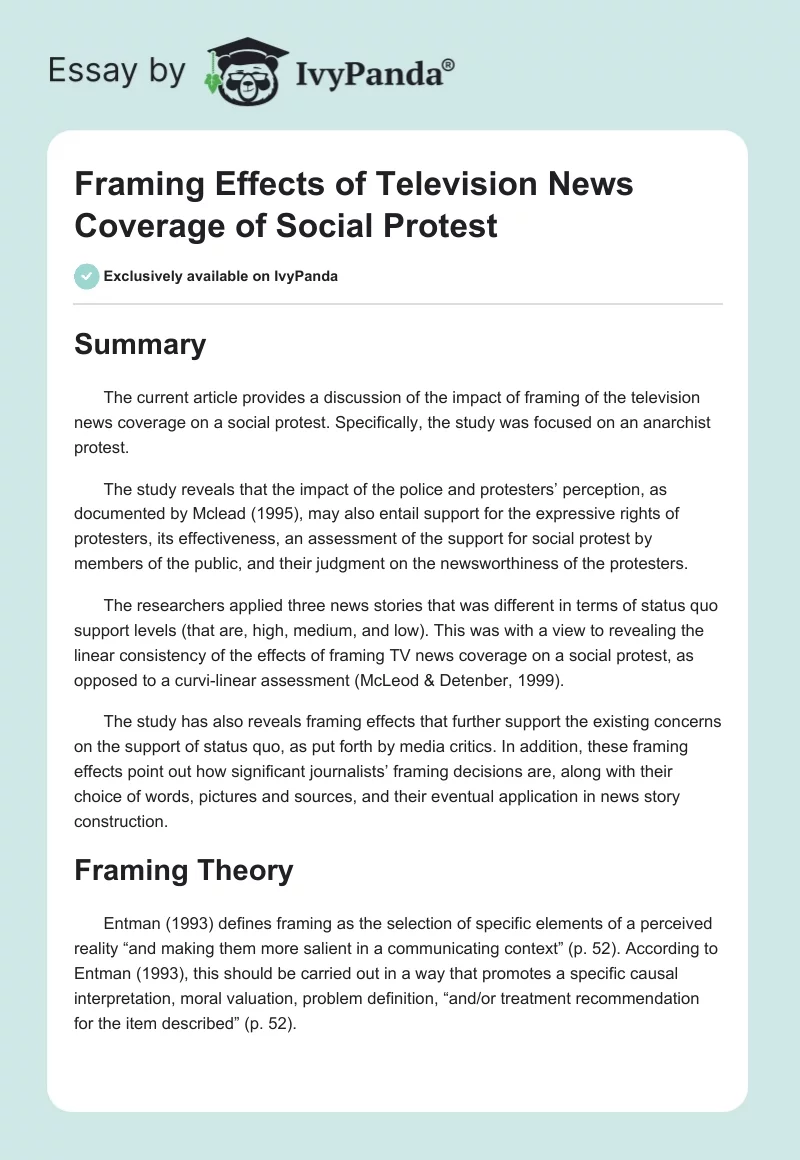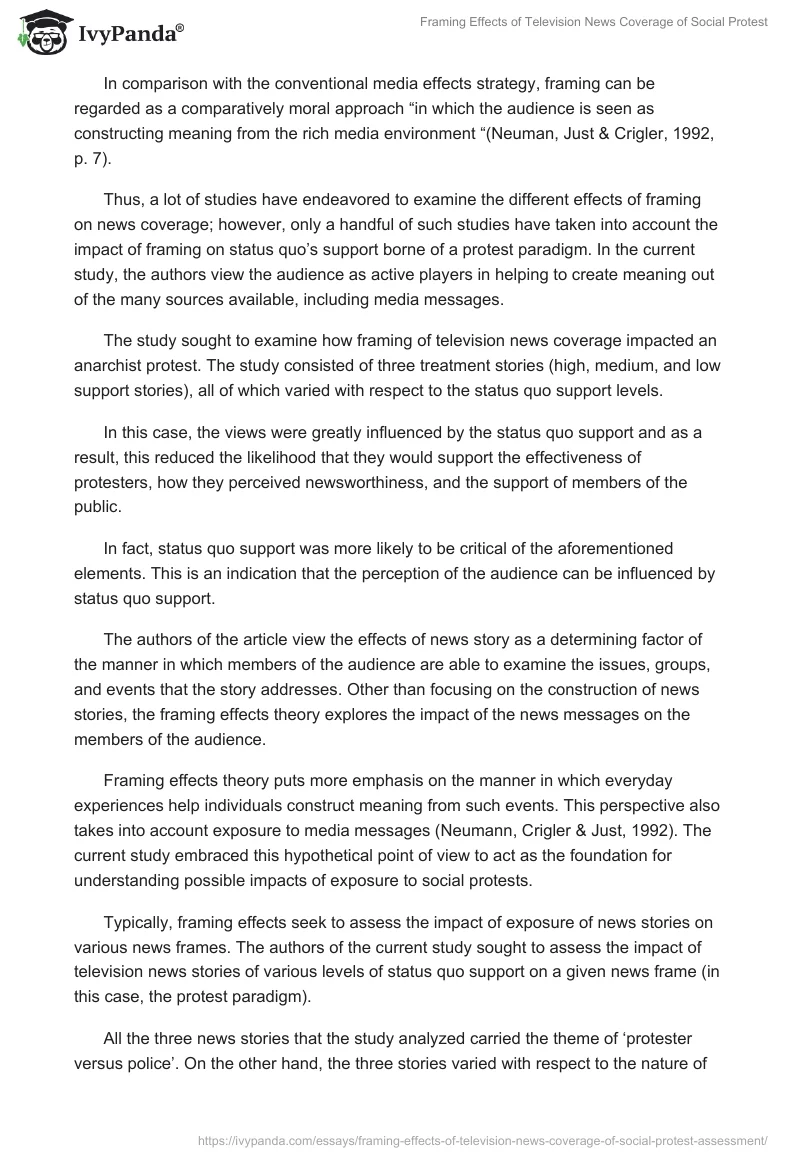Summary
The current article provides a discussion of the impact of framing of the television news coverage on a social protest. Specifically, the study was focused on an anarchist protest.
The study reveals that the impact of the police and protesters’ perception, as documented by Mclead (1995), may also entail support for the expressive rights of protesters, its effectiveness, an assessment of the support for social protest by members of the public, and their judgment on the newsworthiness of the protesters.
The researchers applied three news stories that was different in terms of status quo support levels (that are, high, medium, and low). This was with a view to revealing the linear consistency of the effects of framing TV news coverage on a social protest, as opposed to a curvi-linear assessment (McLeod & Detenber, 1999).
The study has also reveals framing effects that further support the existing concerns on the support of status quo, as put forth by media critics. In addition, these framing effects point out how significant journalists’ framing decisions are, along with their choice of words, pictures and sources, and their eventual application in news story construction.
Framing Theory
Entman (1993) defines framing as the selection of specific elements of a perceived reality “and making them more salient in a communicating context” (p. 52). According to Entman (1993), this should be carried out in a way that promotes a specific causal interpretation, moral valuation, problem definition, “and/or treatment recommendation for the item described” (p. 52).
In comparison with the conventional media effects strategy, framing can be regarded as a comparatively moral approach “in which the audience is seen as constructing meaning from the rich media environment “(Neuman, Just & Crigler, 1992, p. 7).
Thus, a lot of studies have endeavored to examine the different effects of framing on news coverage; however, only a handful of such studies have taken into account the impact of framing on status quo’s support borne of a protest paradigm. In the current study, the authors view the audience as active players in helping to create meaning out of the many sources available, including media messages.
The study sought to examine how framing of television news coverage impacted an anarchist protest. The study consisted of three treatment stories (high, medium, and low support stories), all of which varied with respect to the status quo support levels.
In this case, the views were greatly influenced by the status quo support and as a result, this reduced the likelihood that they would support the effectiveness of protesters, how they perceived newsworthiness, and the support of members of the public.
In fact, status quo support was more likely to be critical of the aforementioned elements. This is an indication that the perception of the audience can be influenced by status quo support.
The authors of the article view the effects of news story as a determining factor of the manner in which members of the audience are able to examine the issues, groups, and events that the story addresses. Other than focusing on the construction of news stories, the framing effects theory explores the impact of the news messages on the members of the audience.
Framing effects theory puts more emphasis on the manner in which everyday experiences help individuals construct meaning from such events. This perspective also takes into account exposure to media messages (Neumann, Crigler & Just, 1992). The current study embraced this hypothetical point of view to act as the foundation for understanding possible impacts of exposure to social protests.
Typically, framing effects seek to assess the impact of exposure of news stories on various news frames. The authors of the current study sought to assess the impact of television news stories of various levels of status quo support on a given news frame (in this case, the protest paradigm).
All the three news stories that the study analyzed carried the theme of ‘protester versus police’. On the other hand, the three stories varied with respect to the nature of interaction. For instance, whereas both the medium and low support stories indicated instances of police clashing with the police, this was not the case with the high support story.
Strengths
Past framing studies were tended to focus on the impact that news stories had on the perceptions of members’ groups, along with an interpretation of the different issues that the news stories covered (McLeod Detenber, 1999). In the case of protest news stories, framing could have an influence on judgments regarding the protesters.
The current study sought to examine various outcomes of framing effects that had not been addressed by previous studies. They include: perceptions of public opinion, support for expressive rights, as well as how newsworthy a news story is.
Pre existing labeling of anarchist groups can reduce the impact on news stories. In this case, the anarchist is usually depicted as a violent bomb-thrower, for example, and hence as a threat to the already established order in the society (Mcleod & Detenber, 1999). They are also seen as a threat to the status quo support.
Nonetheless, the stimulus carried by the current study managed to move participants in spite of the underlying prejudices against anarchists, and hence a source of strength for the article. In addition, the study recorded strong protest-specific findings. This should act as a potential source of motivation for future studies that wish to examine the impact of the long-term exposure.
The questionnaire items asking about the support of the public for the protest, its effectiveness, and its newsworthiness were fewer, resulting in smaller size effects. However, these items tended to be significant, an indication that the cues emanating from the news stories were strong enough to enable them to arrive at such inferences.
Weaknesses
Although the study made use of different messages, nonetheless, they were all tied to a single topic. As a result, there is a chance that some latent or obscure features of the news stories could have had an impact on the study. The study revealed effects that were idiosyncratic to the protest in question. As such, it failed to capture the effects experiencing different protests contexts.
For this reason, it becomes hard to replicate the research findings. Due to the fact that exposure was pegged on a single news story, the framing effects tend to be short-lived as well.
Although this corresponds to the views of Berkowitz and Rogers (1986) who suggest that media influence tends to be by and large temporary, the current study fails to capture the impact of persistence framing effects. Also, since the present study only examined protest from a single context, it was a bit hard for the researchers to document the consistency (or lack of) the media’s status quo.
Discussion Questions
This paper proposes the following discussion questions:
- Even as the media is seen by media sociologists to support marginalizes groups and status quo opposed to official institutions, under what conditions is the media likely to criticize the powers that be?
- Does the media coverage of social protest make group’s language, goals, beliefs and appearances seem more radical than they actually are?
- What are the different news frames that impacts on the causes of social problems, along with the responsibility of finding a solution to such problems.
- While covering a stimulus news story, does the protesters’ criticism of the status quo increase with an increase in status quo support level?
Reference List
Berkowitz, L., & Rogers, K. H. (1986). A priming effect analysis of media influence. In J.
Brant & d Zillmann (Eds), Perspectives on media (pp. 57- 81). Hillsdale, NJ: Erlbaum
Entman, R. M. (1993). Framing: Toward a clarification of a fractured paradigm. Journal of communication, 43(4), 51-58
McLeod, D., & Detenber, B. (1999). Framing effects of television news coverage of social protest. Journal of Communication, 49(3), 3-23
Mcleod, D. M. (1995). Communicating deviance: The effects of television news coverage of social protest. Journal of Broadcasting & Electronic Media, 39, 4- 19.
Neumann, W. R., Just, M. R., & Cryler, A. N. (1992). Common knowledge: News and the construction of political meaning. Chicago: University of Chicago Press.


